ECO mode MITSUBISHI SHOGUN 2008 (in English) Owner's Guide
[x] Cancel search | Manufacturer: MITSUBISHI, Model Year: 2008, Model line: SHOGUN, Model: MITSUBISHI SHOGUN 2008Pages: 538, PDF Size: 25.09 MB
Page 104 of 538
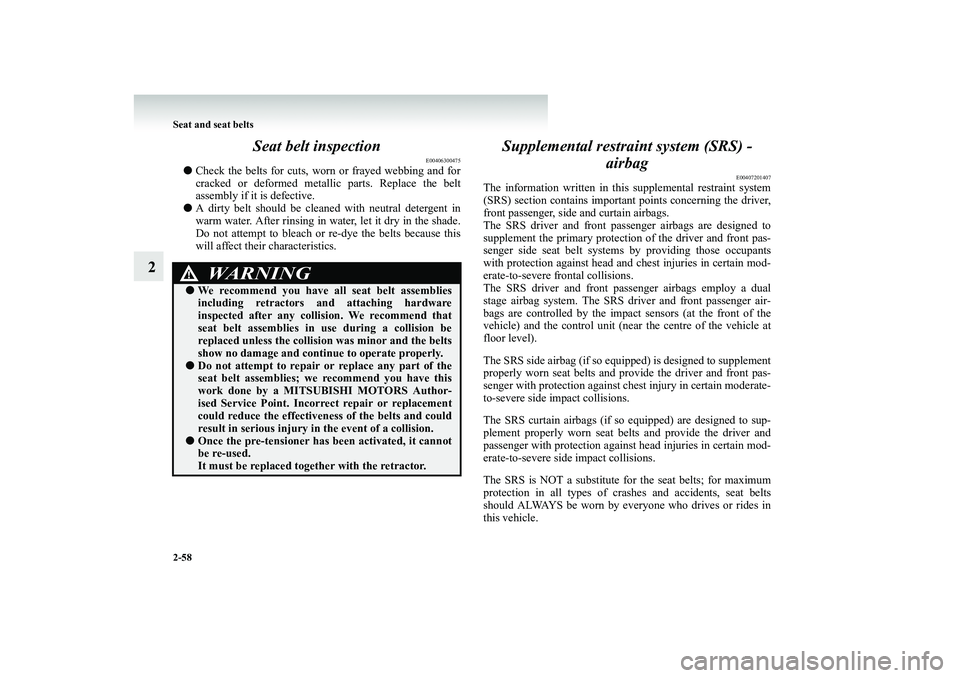
2-58 Seat and seat belts
2
Seat belt inspection
E00406300475
●
Check the belts for cuts, worn
or frayed webbing and for
cracked or deformed metallic parts. Replace the belt assembly if it is defective.
●
A dirty belt should be cleaned with neutral detergent in warm water. After rinsing in water, let it dry in the shade. Do not attempt to bleach or
re-dye the belts because this
will affect their characteristics.
Supplemental restra
int system (SRS) -
airbag
E00407201407
The information written in this supplemental restraint system (SRS) section contains important points concerning the driver, front passenger, side and curtain airbags.The SRS driver and front passe
nger airbags are designed to
supplement the primary protection of the driver and front pas- senger side seat belt systems by providing those occupantswith protection against head and
chest injuries in certain mod-
erate-to-severe frontal collisions. The SRS driver and front passenger airbags employ a dualstage airbag system. The SRS
driver and front passenger air-
bags are controlled by the imp
act sensors (at the front of the
vehicle) and the control unit (n
ear the centre of
the vehicle at
floor level). The SRS side airbag (if so equipped) is designed to supplement properly worn seat belts and provide the driver and front pas-senger with protection against ches
t injury in certain moderate-
to-severe side impact collisions. The SRS curtain airbags (if so
equipped) are designed to sup-
plement properly worn seat belts and provide the driver andpassenger with protection against head injuries in certain mod- erate-to-severe side
impact collisions.
The SRS is NOT a substitute for the seat belts; for maximum protection in all types of cras
hes and accidents, seat belts
should ALWAYS be worn by everyone who drives or rides in this vehicle.
WARNING
!●
We recommend you have al
l seat belt assemblies
including retractors and attaching hardware inspected after any collision. We recommend that seat belt assemblies in use during a collision bereplaced unless the collis
ion was minor and the belts
show no damage and contin
ue to operate properly.
●
Do not attempt to repair or replace any part of the seat belt assemblies; we recommend you have this work done by a MITSUB
ISHI MOTORS Author-
ised Service Point. Incorrect repair or replacementcould reduce the effectivene
ss of the belts and could
result in serious injury in
the event of a collision.
●
Once the pre-tensioner has b
een activated, it cannot
be re-used. It must be replaced together with the retractor.
BK-BK2008E1ENUK.en-uk-Section5.fm Page
58 Wednesday, January 9, 2008 4:28 PM
Page 116 of 538
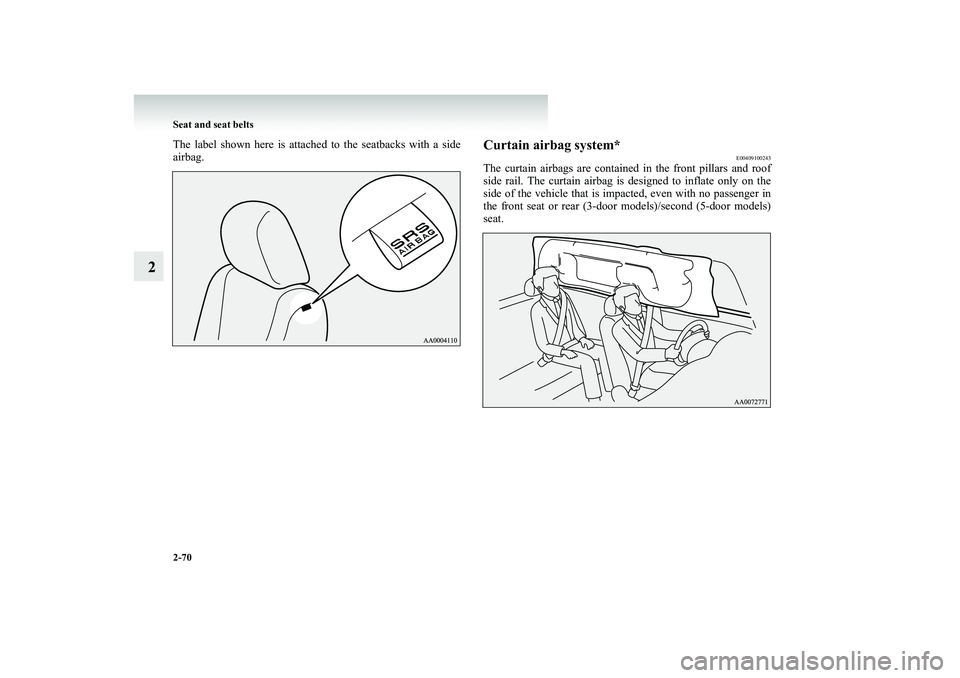
2-70 Seat and seat belts
2
The label shown here is attached to the seatbacks with a side airbag.
Curtain airbag system*
E00409100243
The curtain airbags are contained in the front pillars and roofside rail. The curtain
airbag is designed to
inflate only on the
side of the vehicle that is imp
acted, even with
no passenger in
the front seat or rear (3-door
models)/second (5-door models)
seat.
BK-BK2008E1ENUK.en-uk-Section5.fm Page
70 Wednesday, January 9, 2008 4:28 PM
Page 146 of 538
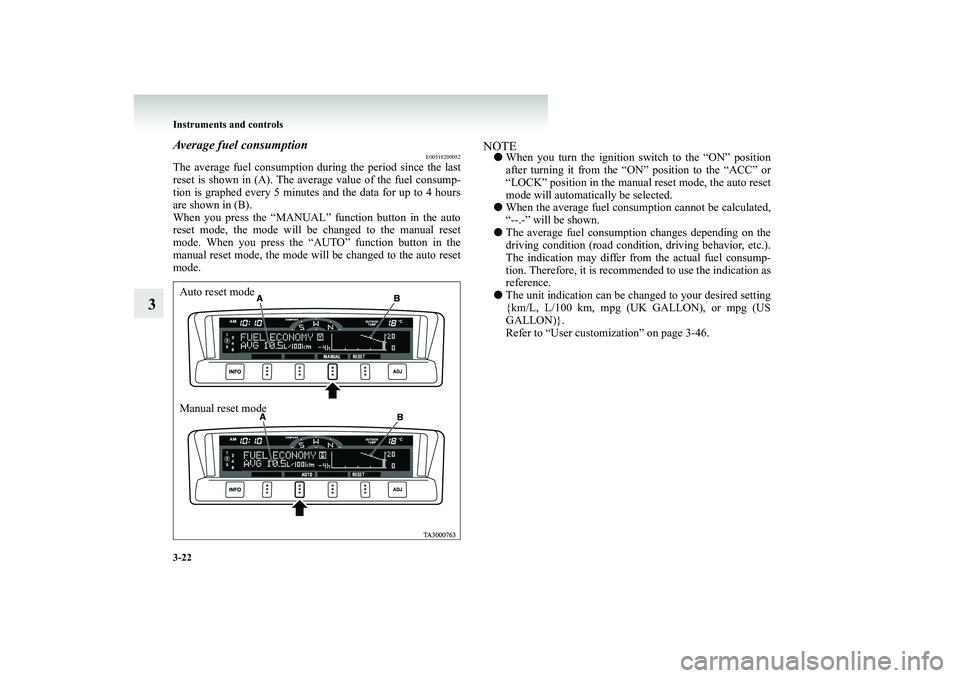
3-22 Instruments and controls
3
Average fuel consumption
E00518200052
The average fuel consumption
during the period since the last
reset is shown in (A). The aver
age value of the fuel consump-
tion is graphed every 5 minutes and the data for up to 4 hoursare shown in (B). When you press the “MANUAL”
function button in the auto
reset mode, the mode will be changed to the manual resetmode. When you press the “AUTO” function button in the manual reset mode, the mode will be changed to the auto reset mode.
NOTE●
When you turn the ignition sw
itch to the “ON” position
after turning it from the “ON” position to the “ACC” or “LOCK” position in the manual reset mode, the auto reset mode will automatically be selected.
●
When the average fuel cons
umption cannot be calculated,
“--.-” will be shown.
●
The average fuel consumptio
n changes depending on the
driving condition (road condition, driving behavior, etc.). The indication may differ from the actual fuel consump- tion. Therefore, it is reco
mmended to use the indication as
reference.
●
The unit indication can be changed to your desired setting {km/L, L/100 km, mpg (UK GALLON), or mpg (USGALLON)}. Refer to “User customization” on page 3-46.
Auto reset mode Manual reset mode
BK-BK2008E1ENUK.en-uk-Section6.fm Page
22 Wednesday, January 9, 2008 4:32 PM
Page 203 of 538
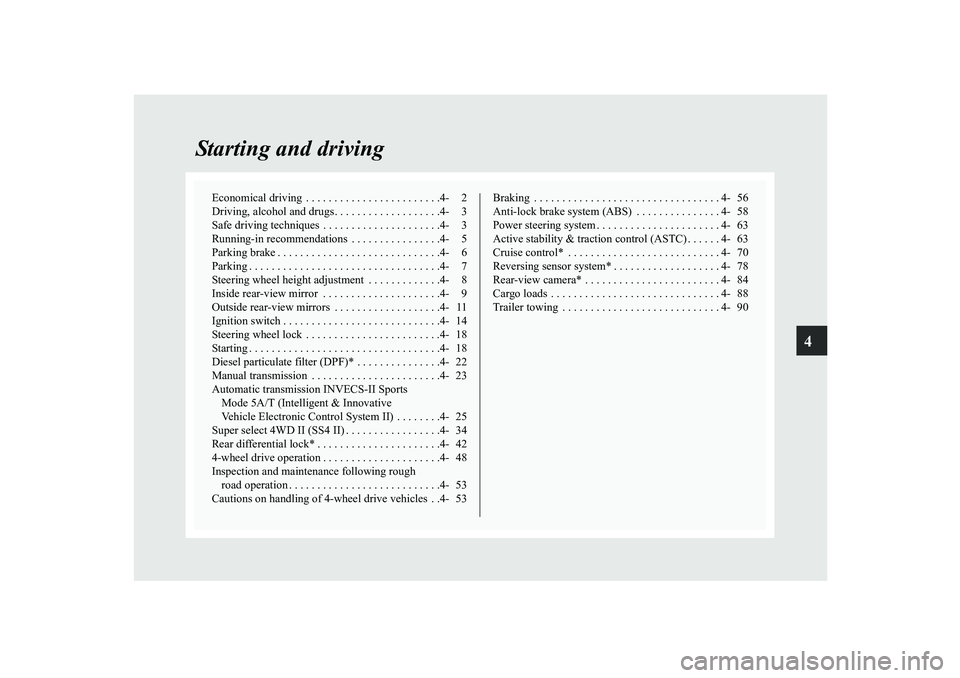
4
Starting and driving
Economical driving . . . . . . . . . . . . . . . . . . . . . . . .4- 2 Driving, alcohol and drugs. . . . . . . . . . . . . . . . . . .4- 3Safe driving techniques . . . . . . . . . . . . . . . . . . . . .4- 3Running-in recommendations . . . . . . . . . . . . . . . .4- 5Parking brake . . . . . . . . . . . . . . . . . . . . . . . . . . . . .4- 6Parking . . . . . . . . . . . . . . . . . . . . . . . . . . . . . . . . . .4- 7Steering wheel height adjustment . . . . . . . . . . . . .4- 8Inside rear-view mirror . . . . .
. . . . . . . . . . . . . . . .4- 9
Outside rear-view mirrors . . . . . . . . . . . . . . . . . . .4- 11Ignition switch . . . . . . . . . . . . . . . . . . . . . . . . . . . .4- 14Steering wheel lock . . . . . . . . . . . . . . . . . . . . . . . .4- 18Starting . . . . . . . . . . . . . . . . . . . . . . . . . . . . . . . . . .4- 18Diesel particulate filter (DPF)* . . . . . . . . . . . . . . .4- 22Manual transmission . . . . . . . . . . . . . . . . . . . . . . .4- 23Automatic transmission INVECS-II Sports Mode 5A/T (Intelligent & Innovative Vehicle Electronic Control Syst
em II) . . . . . . . .4- 25
Super select 4WD II (SS4 II) . . . . . . . . . . . . . . . . .4- 34Rear differential lock* . . . . . . . . . . . . . . . . . . . . . .4- 424-wheel drive operation . . . . . . . . . . . . . . . . . . . . .4- 48Inspection and maintenance following rough road operation . . . . . . . . . . . . . . . . . . . . . . . . . . .4- 53Cautions on handling of 4-wheel drive vehicles . .4- 53
Braking . . . . . . . . . . . . . . . . . . . . . . . . . . . . . . . . . 4- 56 Anti-lock brake system (ABS) . . . . . . . . . . . . . . . 4- 58Power steering system . . . . . . . . . . . . . . . . . . . . . . 4- 63Active stability & traction control (ASTC) . . . . . . 4- 63Cruise control* . . . . . . . . . . . . . . . . . . . . . . . . . . . 4- 70Reversing sensor system* . . . . . . . . . . . . . . . . . . . 4- 78Rear-view camera* . . . . . . . . . . . . . . . . . . . . . . . . 4- 84Cargo loads . . . . . . . . . . . . . . . . . . . . . . . . . . . . . . 4- 88Trailer towing . . . . . . . . . . . . . . . . . . . . . . . . . . . . 4- 90
BK-BK2008E1ENUK.en-uk-Section7.fm Page 1 Wednesday, January 9, 2008 4:36 PM
Page 207 of 538
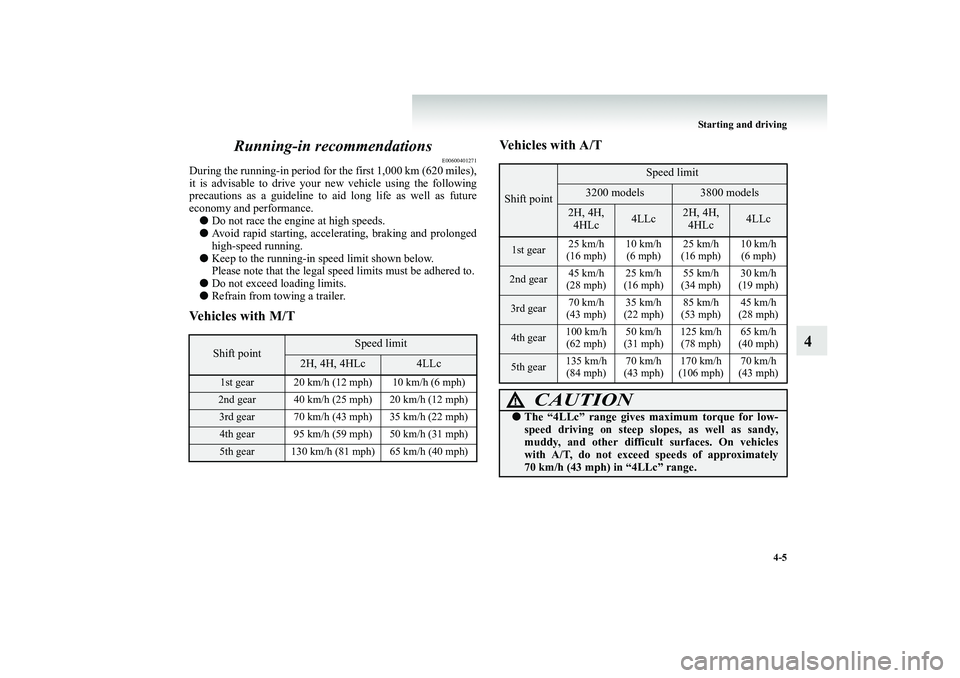
Starting and driving
4-5
4
Running-in recommendations
E00600401271
During the running-in period for the first 1,000 km (620 miles), it is advisable to drive your new vehicle using the following precautions as a guideline to aid
long life as well as future
economy and performance. ●
Do not race the engine at high speeds.
●
Avoid rapid starting, accelerat
ing, braking and prolonged
high-speed running.
●
Keep to the running-in speed limit shown below. Please note that the legal speed limits must be adhered to.
●
Do not exceed loading limits.
●
Refrain from towing a trailer.
Vehicles with M/T
Vehicles with A/T
Shift point
Speed limit
2H, 4H, 4HLc
4LLc
1st gear 20 km/h (12 mph) 10 km/h (6 mph)2nd gear 40 km/h (25 mph) 20 km/h (12 mph)3rd gear 70 km/h (43 mph) 35 km/h (22 mph)4th gear 95 km/h (59 mph) 50 km/h (31 mph)5th gear 130 km/h (81 mph) 65 km/h (40 mph)
Shift point
Speed limit
3200 models
3800 models
2H, 4H, 4HLc
4LLc
2H, 4H, 4HLc
4LLc
1st gear
25 km/h (16 mph)
10 km/h (6 mph)
25 km/h (16 mph)
10 km/h (6 mph)
2nd gear
45 km/h (28 mph)
25 km/h (16 mph)
55 km/h (34 mph)
30 km/h (19 mph)
3rd gear
70 km/h (43 mph)
35 km/h (22 mph)
85 km/h (53 mph)
45 km/h (28 mph)
4th gear
100 km/h (62 mph)
50 km/h (31 mph)
125 km/h (78 mph)
65 km/h (40 mph)
5th gear
135 km/h (84 mph)
70 km/h (43 mph)
170 km/h (106 mph)
70 km/h (43 mph)
CAUTION
!●
The “4LLc” range gives maximum torque for low- speed driving on steep slopes, as well as sandy, muddy, and other difficul
t surfaces. On vehicles
with A/T, do not exceed
speeds of approximately
70 km/h (43 mph) in “4LLc” range.
BK-BK2008E1ENUK.en-uk-Section7.fm Page 5 Wednesday, January 9, 2008 4:36 PM
Page 222 of 538
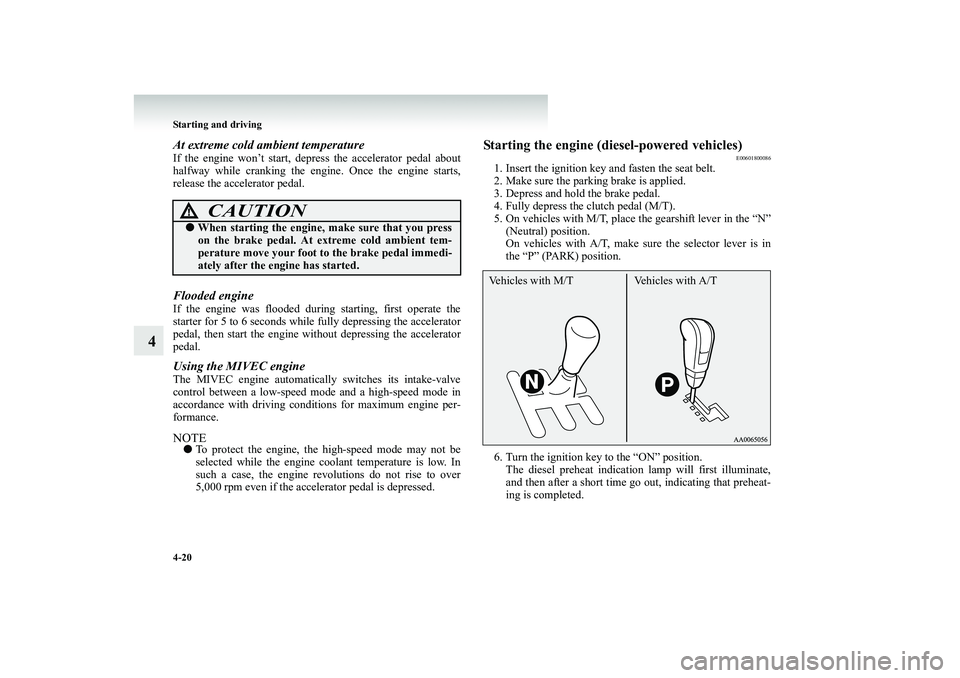
4-20 Starting and driving
4
At extreme cold ambient temperatureIf the engine won’t start, de
press the accelerator pedal about
halfway while cranking the engi
ne. Once the engine starts,
release the accelerator pedal.Flooded engineIf the engine was flooded during starting, first operate the starter for 5 to 6 seconds whil
e fully depressing the accelerator
pedal, then start the engine
without depressing the accelerator
pedal.Using the MIVEC engineThe MIVEC engine automatically switches its intake-valve control between a low-speed mo
de and a high-speed mode in
accordance with driving conditi
ons for maximum engine per-
formance.NOTE●
To protect the engine, the high-speed mode may not be selected while the engine coolant temperature is low. In such a case, the engine revo
lutions do not rise to over
5,000 rpm even if the acceler
ator pedal is depressed.
Starting the engine (d
iesel-powered vehicles)
E00601800086
1. Insert the ignition key and fasten the seat belt. 2. Make sure the parking brake is applied. 3. Depress and hold the brake pedal. 4. Fully depress the clutch pedal (M/T).5. On vehicles with M/T, place
the gearshift lever in the “N”
(Neutral) position. On vehicles with A/T, make sure the selector lever is inthe “P” (PARK) position.
6. Turn the ignition key to the “ON” position.
The diesel preheat indication lamp will first illuminate,and then after a short time go
out, indicating that preheat-
ing is completed.
CAUTION
!●
When starting the engine, make sure that you press on the brake pedal. At extreme cold ambient tem- perature move your foot
to the brake pedal immedi-
ately after the en
gine has started.
Vehicles with M/T Vehicles with A/T
BK-BK2008E1ENUK.en-uk-Section7.fm Page
20 Wednesday, January 9, 2008 4:36 PM
Page 227 of 538
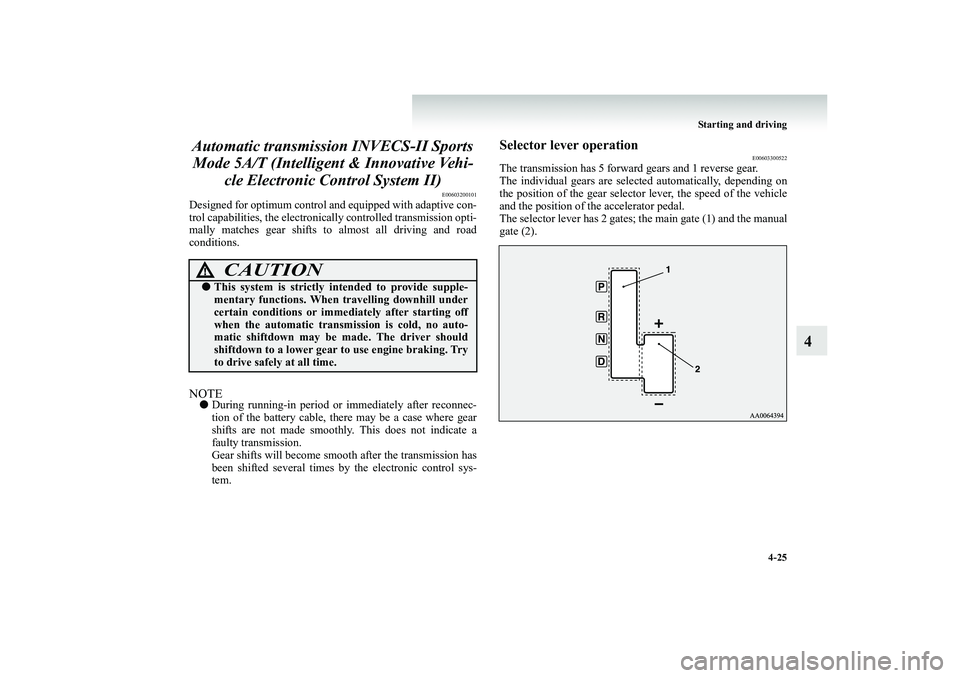
Starting and driving
4-25
4
Automatic transmissi
on INVECS-II Sports
Mode 5A/T (Intellige
nt & Innovative Vehi-
cle Electronic Control System II)
E00603200101
Designed for optimum control and equipped with adaptive con- trol capabilities, the electronica
lly controlled transmission opti-
mally matches gear shifts to almost all driving and roadconditions.NOTE●
During running-in period or immediately after reconnec- tion of the battery cable, there may be a case where gear shifts are not made smoothly. This does not indicate afaulty transmission. Gear shifts will become smoot
h after the transmission has
been shifted several times by
the electronic control sys-
tem.
Selector lever operation
E00603300522
The transmission has 5 forwar
d gears and 1 reverse gear.
The individual gears are select
ed automatically, depending on
the position of the gear
selector lever, the speed of the vehicle
and the position of the accelerator pedal.The selector lever has 2 gates; the main gate (1) and the manual gate (2).
CAUTION
!●
This system is strictly in
tended to provide supple-
mentary functions. When travelling downhill under certain conditions or immedi
ately after st
arting off
when the automatic transmission is cold, no auto-matic shiftdown may be made. The driver should shiftdown to a lower gear to use engine braking. Try to drive safely at all time.
BK-BK2008E1ENUK.en-uk-Section7.fm Page
25 Wednesday, January 9, 2008 4:36 PM
Page 233 of 538
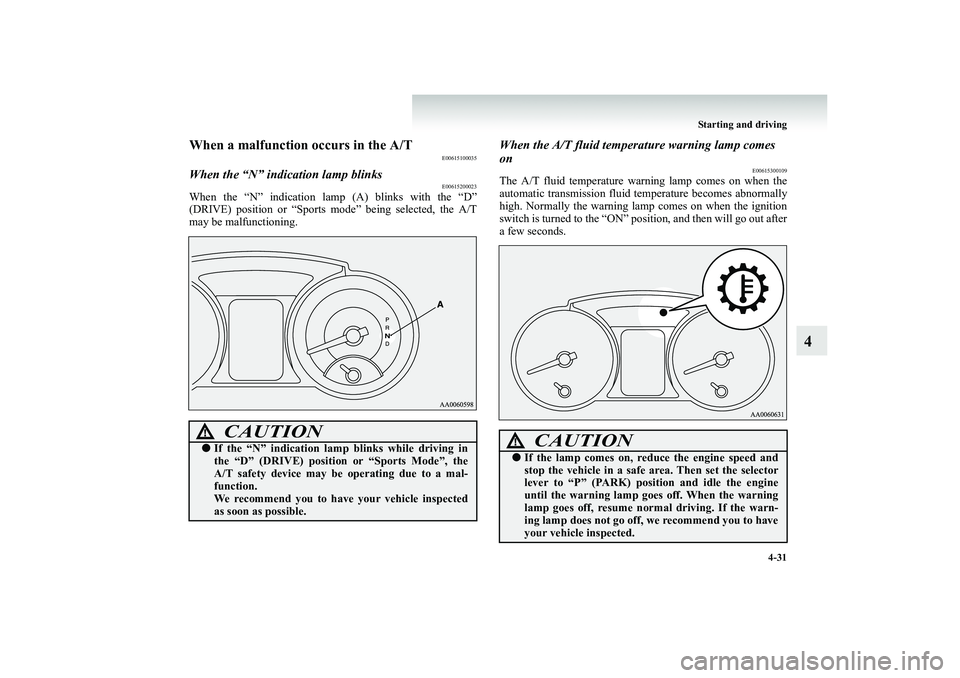
Starting and driving
4-31
4
When a malfunction occurs in the A/T
E00615100035
When the “N” indication lamp blinks
E00615200023
When the “N” indication lamp
(A) blinks with the “D”
(DRIVE) position or “Sports m
ode” being selected, the A/T
may be malfunctioning.
When the A/T fluid temper
ature warning lamp comes
on
E00615300109
The A/T fluid temperature warn
ing lamp comes on when the
automatic transmission fluid
temperature becomes abnormally
high. Normally the warning lamp comes on when the ignitionswitch is turned to the “ON” pos
ition, and then will go out after
a few seconds.
CAUTION
!●
If the “N” indication lamp blinks while driving in the “D” (DRIVE) position or “Sports Mode”, the A/T safety device may be operating due to a mal-function. We recommend you to have your vehicle inspected as soon as possible.
CAUTION
!●
If the lamp comes on, re
duce the engine speed and
stop the vehicle in a safe
area. Then set the selector
lever to “P” (PARK) posi
tion and idle the engine
until the warning
lamp goes off.
When the warning
lamp goes off, resume norm
al driving. If the warn-
ing lamp does not go off, we recommend you to have your vehicle inspected.
BK-BK2008E1ENUK.en-uk-Section7.fm Page
31 Wednesday, January 9, 2008 4:36 PM
Page 236 of 538
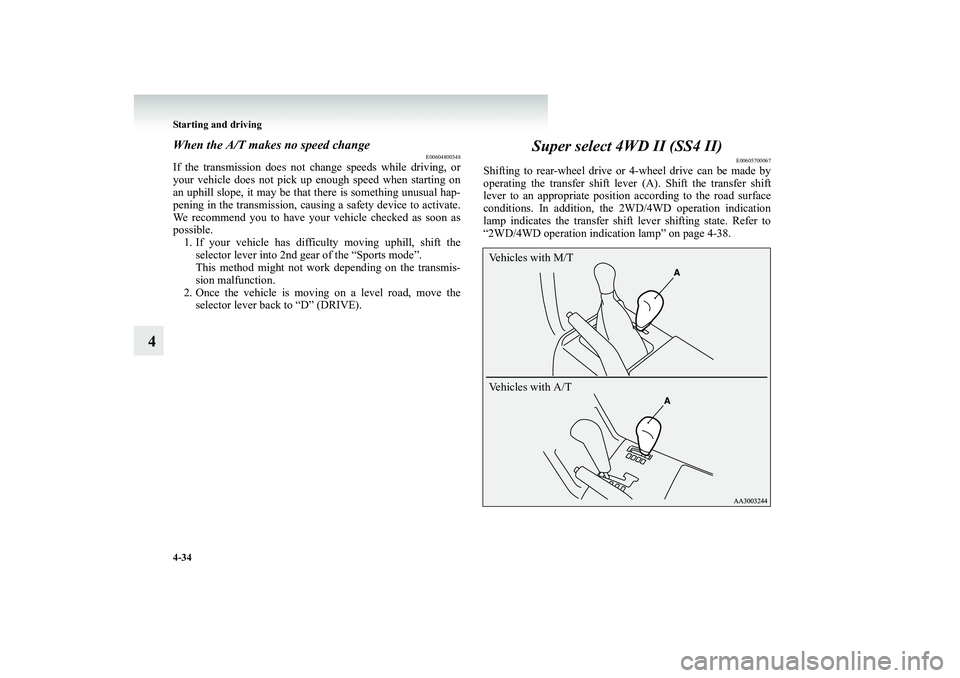
4-34 Starting and driving
4
When the A/T makes no speed change
E00604800348
If the transmission does not ch
ange speeds while driving, or
your vehicle does not pick up enough speed when starting on an uphill slope, it may be that there is something unusual hap-pening in the transmission, causi
ng a safety device to activate.
We recommend you to have your vehicle checked as soon as possible.1. If your vehicle has difficulty moving uphill, shift the
selector lever into 2nd gear of the “Sports mode”. This method might not work depending on the transmis-sion malfunction.
2. Once the vehicle is moving on a level road, move the
selector lever back to “D” (DRIVE).
Super select 4WD II (SS4 II)
E00605700067
Shifting to rear-wheel drive or
4-wheel drive can be made by
operating the transfer shift lever
(A). Shift the transfer shift
lever to an appropriate position according to the road surfaceconditions. In addition, the 2WD/4WD operation indication lamp indicates the transfer shif
t lever shifting state. Refer to
“2WD/4WD operation indicat
ion lamp” on page 4-38.
Vehicles with M/T Vehicles with A/T
BK-BK2008E1ENUK.en-uk-Section7.fm Page
34 Wednesday, January 9, 2008 4:36 PM
Page 256 of 538
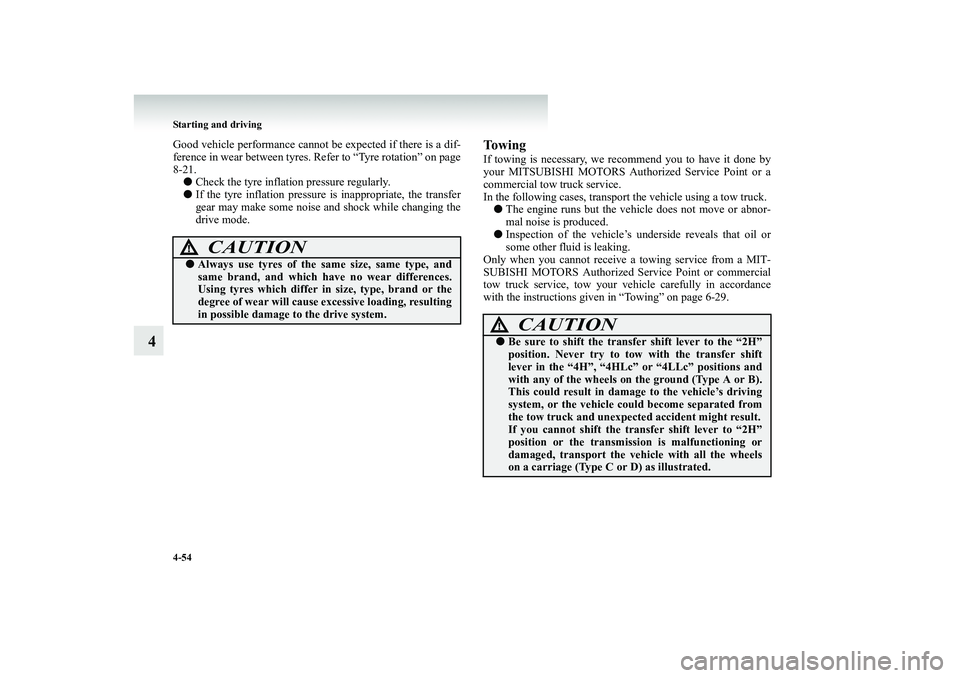
4-54 Starting and driving
4
Good vehicle performance cannot be expected if there is a dif- ference in wear between tyres. Refer to “Tyre rotation” on page 8-21. ●
Check the tyre inflation pressure regularly.
●
If the tyre inflation pressure
is inappropriate, the transfer
gear may make some noise and shock while changing the drive mode.
To w i n gIf towing is necessary, we recommend you to have it done byyour MITSUBISHI MOTORS Authorized Service Point or acommercial tow
truck service.
In the following cases, transpor
t the vehicle using a tow truck.
●
The engine runs but the vehicle does not move or abnor- mal noise is produced.
●
Inspection of the vehicle’s und
erside reveals that oil or
some other fluid is leaking.
Only when you cannot receive a towing service from a MIT- SUBISHI MOTORS Authorized
Service Point or commercial
tow truck service, tow your ve
hicle carefully in accordance
with the instructions given in “Towing” on page 6-29.
CAUTION
!●
Always use tyres of the same size, same type, and same brand, and which have no wear differences.Using tyres which differ in size, type, brand or the degree of wear will cause excessive loading, resulting in possible damage to the drive system.
CAUTION
!●
Be sure to shift the tran
sfer shift lever to the “2H”
position. Never try to tow with the transfer shift lever in the “4H”, “4HLc” or “4LLc” positions and with any of the wheels on
the ground (Type A or B).
This could result in damage to the vehicle’s driving system, or the vehicle could become separated from the tow truck and unexpected
accident might result.
If you cannot shift the tr
ansfer shift lever to “2H”
position or the transmission is malfunctioning or damaged, transport the ve
hicle with all the wheels
on a carriage (Type C or D) as illustrated.
BK-BK2008E1ENUK.en-uk-Section7.fm Page
54 Wednesday, January 9, 2008 4:36 PM